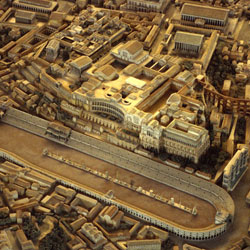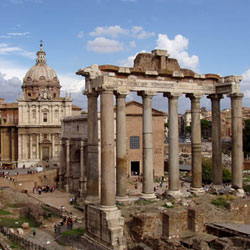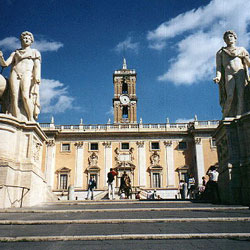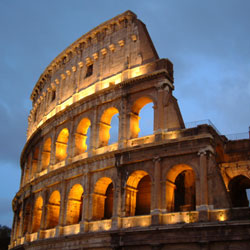Rome Tours
Monumental Rome | Archaeological | St. Peter Basilica, the Vatican and Sistine Chapel | Trevi Fountain, the Catacombs, Appian Way, Borghese Gallery
The Forum, Capitol Hill and Museum, Coliseum
The capital of Italy is probably the most visited city in the world. Whilst, arguably, for the Italians Rome is primarily the political centre of the nation, for others it is its wealth of architectural and artistic treasures which makes it a truly remarkable and unforgettable city. The numerous museums, monuments and churches, not to mention the archaeological sites, represent a cultural heritage so vast that a whole lifetime would not be sufficient to explore it in its entirety.
This is why if you visit the city of Rome... non basta una vita per visitarla, is not enough a life time to visit the Eternal City.
Suggested day tour drive and walking tour of archaeological Rome, with the visit of Palatine Hill and House of Emperor Augustus, Roman Forum, Coliseum, Capitol Hill Museum, Piazza Navona and Trevi Fountain, the service is driver/guided and is individually personalized.
Monumental Rome | Archaeological | St. Peter Basilica, the Vatican and Sistine Chapel | Trevi Fountain, the Catacombs, Appian Way, Borghese Gallery
The Forum, Capitol Hill and Museum, Coliseum
The capital of Italy is probably the most visited city in the world. Whilst, arguably, for the Italians Rome is primarily the political centre of the nation, for others it is its wealth of architectural and artistic treasures which makes it a truly remarkable and unforgettable city. The numerous museums, monuments and churches, not to mention the archaeological sites, represent a cultural heritage so vast that a whole lifetime would not be sufficient to explore it in its entirety.
This is why if you visit the city of Rome... non basta una vita per visitarla, is not enough a life time to visit the Eternal City.
Suggested day tour drive and walking tour of archaeological Rome, with the visit of Palatine Hill and House of Emperor Augustus, Roman Forum, Coliseum, Capitol Hill Museum, Piazza Navona and Trevi Fountain, the service is driver/guided and is individually personalized.
| Palatine Hill and house of Emperor Augustus. According to legend, it was on the Palatine Hill that Romulus and Remo were discovered by the she-wolf who subsequently raised them, and where Romulus later founded the city of Rome. What is certain, thanks to recent excavations, is that the area was already inhabited in the VIII century B.C. The hill was home to various sites of worship, including that of the Magna Mater. In addition, between the II and I century B.C., the Palatine Hill became the residential quarter of the Roman aristocracy, populated by numerous villas including that of the House of the Griffins, famous for the beautiful paintings still visible on its walls. Under the reign of Augustus, the Palatine Hill was chosen as the Empire's seat of power and imperial palaces were built here, including the Palazzo dei Cesari which today houses the Palatine Museum. Between the Palatine and Aventine hills, there is the majestic Circus Maximus. The Roman circus served as hippodrome and venue for public games. Originally, it was 621 meters long and 118 metes wide, with a capacity for some 250 thousand spectators. Overlooking the Circus Maximus there is the Aventine hill, also known as the hill of San Saba. Traditionally, the hill was inhabited by the plebeians but it was also an active commercial center, thanks to its vicinity to the port on the river Tevere. From the Circus Maximus visitors quickly reach the Baths of Caracalla and the Appian Way, this latter considered to be the most important of the Empire's thoroughfares, a section of which is now protected within the Appia Antica Regional Suburban Park. |
 |
| Roman Forum. The road which departs from Piazza Venezia to reach the Coliseum crosses the entire area of the Imperial Forums and the Traiano Market, which constitutes the largest archaeological city in the world. From the Vittoriano, along the Via dei Fori Imperiali one comes across the ruins of the Forum of Caesar and the Temple of Venere Genetrice, commissioned by Caesar prior to the battle of Farsalo; the Traiano Forum with the remains of the Ulpia Basilica, considered to be the largest of ancient Rome; the 40 meter high Traiana Column which depicts salient episodes from the military operations of Traiano against the Daci; the Forum of Augustus, which commemorates the victory of Filippi and is dedicated to Marte Ultore; the Forum of Nerva, where the Temple of the Minerva was constructed and of which only the basement has survived; the Roman and Palatine Forum, the Church of St Cosma and St Damiano with its fabulous mosaics and the Church of St Luca and St Martina. At the end of the Via dei Fori Imperiali one arrives at the Coliseum. |
 |
| Capitol Hill and the Museum Piazza del Campidoglio originates from a design by the great Michelangelo Buonarroti, facing San Pietro, with an equestrian statue by Marco Aurelio at its center, transfered here in 1538 from the Laterano on the request of Pope Paolo III. In the Piazza del Campidoglio one finds Palazzo Senatorio, work of Giacomo Della Porta and Girolamo Rainaldi, in which Rome's County Council meets; Palazzo Nuovo, designed by the Rainaldi Brothers; Palazzo dei Conservatori, the construction of which was initiated by Michelangelo Buonarroti and completed by Giacomo Della Porta; the Pinacoteca Capitolina, which houses an impressive collection of paintings from the Middle Ages to the late XVIII century, including works by Titian, Veronese, Rubens, Caravaggio and Pietro da Cortona. Within the vicinity of Piazza del Campidoglio one can visit the medieval Church of St Maria in Aracoeli, the Fortuna Virile Temple, the Vesta Temple, the Church of St Maria in Cosmedin, the Church of St Sabina and the Church of St Alessio and Bonifacio. |
 |
| Coliseum The Anfiteatro Flavio, known throughout the world, the Coliseum is symbolic of the city of Rome. It is 50 meters high, 86 meters long and 54 meters wide, distributed on a structure of elliptic form. It was built under the rule of the Emperor Vespasiano on an artificial lake in 79 A.D. The Coliseum was inaugurated by Tito and became the theatre of frighteningly cruel games, in which gladiators fought each other and lions were let loose on human beings who were destined to be mauled to death. In the lower part of the Coliseum one can see the underground passages and the tunnels where the lions were kept. The Coliseum was later used as a source of materials for building works. Near to the Coliseum one finds Costantino's Arch which has to be the best example of the "recycling" carried out during the crisis of the Massenzio Empire in 312 A.D. The Domus Area, once the residential quarters of Nerone which were built after the terrible fire of 64 A.D., is close by in the Colle Oppio Park. We will end to tour with the visit of Piazza Navona and the famous Trevi Fountain, a monument known throughout the World, where to throw a coin in the waters is said to guarantee the owner’s return to the “ Eternal City”. |
 |